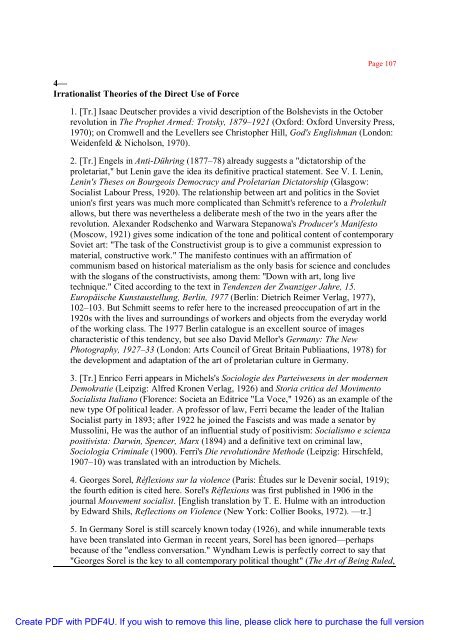131214840-Carl-Schmitt
131214840-Carl-Schmitt
131214840-Carl-Schmitt
- No tags were found...
Create successful ePaper yourself
Turn your PDF publications into a flip-book with our unique Google optimized e-Paper software.
Page 107<br />
4—<br />
Irrationalist Theories of the Direct Use of Force<br />
1. [Tr.] Isaac Deutscher provides a vivid description of the Bolshevists in the October<br />
revolution in The Prophet Armed: Trotsky, 1879–1921 (Oxford: Oxford Unversity Press,<br />
1970); on Cromwell and the Levellers see Christopher Hill, God's Englishman (London:<br />
Weidenfeld & Nicholson, 1970).<br />
2. [Tr.] Engels in Anti-Dühring (1877–78) already suggests a "dictatorship of the<br />
proletariat," but Lenin gave the idea its definitive practical statement. See V. I. Lenin,<br />
Lenin's Theses on Bourgeois Democracy and Proletarian Dictatorship (Glasgow:<br />
Socialist Labour Press, 1920). The relationship between art and politics in the Soviet<br />
union's first years was much more complicated than <strong>Schmitt</strong>'s reference to a Proletkult<br />
allows, but there was nevertheless a deliberate mesh of the two in the years after the<br />
revolution. Alexander Rodschenko and Warwara Stepanowa's Producer's Manifesto<br />
(Moscow, 1921) gives some indication of the tone and political content of contemporary<br />
Soviet art: "The task of the Constructivist group is to give a communist expression to<br />
material, constructive work." The manifesto continues with an affirmation of<br />
communism based on historical materialism as the only basis for science and concludes<br />
with the slogans of the constructivists, among them: ''Down with art, long live<br />
technique." Cited according to the text in Tendenzen der Zwanziger Jahre, 15.<br />
Europäische Kunstaustellung, Berlin, 1977 (Berlin: Dietrich Reimer Verlag, 1977),<br />
102–103. But <strong>Schmitt</strong> seems to refer here to the increased preoccupation of art in the<br />
1920s with the lives and surroundings of workers and objects from the everyday world<br />
of the working class. The 1977 Berlin catalogue is an excellent source of images<br />
characteristic of this tendency, but see also David Mellor's Germany: The New<br />
Photography, 1927–33 (London: Arts Council of Great Britain Publiaations, 1978) for<br />
the development and adaptation of the art of proletarian culture in Germany.<br />
3. [Tr.] Enrico Ferri appears in Michels's Sociologie des Parteiwesens in der modernen<br />
Demokratie (Leipzig: Alfred Kronen Verlag, 1926) and Storia critica del Movimento<br />
Socialista Italiano (Florence: Societa an Editrice "La Voce," 1926) as an example of the<br />
new type Of political leader. A professor of law, Ferri became the leader of the Italian<br />
Socialist party in 1893; after 1922 he joined the Fascists and was made a senator by<br />
Mussolini, He was the author of an influential study of positivism: Socialismo e scienza<br />
positivista: Darwin, Spencer, Marx (1894) and a definitive text on criminal law,<br />
Sociologia Criminale (1900). Ferri's Die revolutionäre Methode (Leipzig: Hirschfeld,<br />
1907–10) was translated with an introduction by Michels.<br />
4. Georges Sorel, Réflexions sur la violence (Paris: Études sur le Devenir social, 1919);<br />
the fourth edition is cited here. Sorel's Réflexions was first published in 1906 in the<br />
journal Mouvement socialist. [English translation by T. E. Hulme with an introduction<br />
by Edward Shils, Reflections on Violence (New York: Collier Books, 1972). —tr.]<br />
5. In Germany Sorel is still scarcely known today (1926), and while innumerable texts<br />
have been translated into German in recent years, Sorel has been ignored—perhaps<br />
because of the "endless conversation." Wyndham Lewis is perfectly correct to say that<br />
"Georges Sorel is the key to all contemporary political thought" (The Art of Being Ruled,<br />
Create PDF with PDF4U. If you wish to remove this line, please click here to purchase the full version


